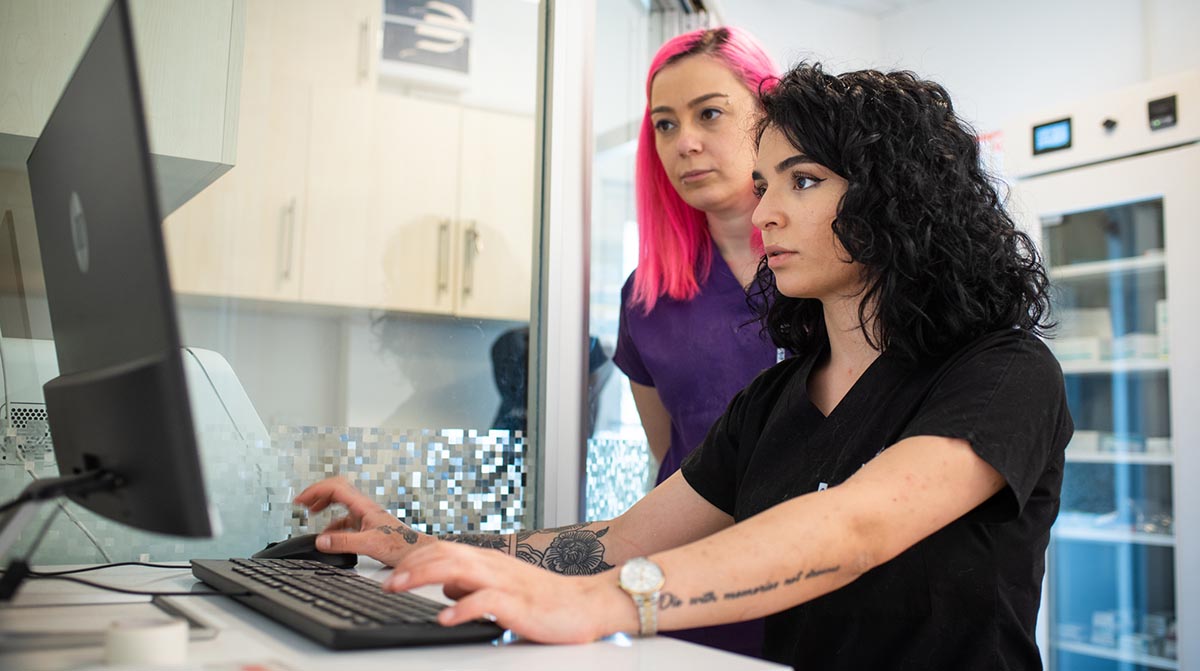Ranking well on Google Search is vital to your veterinary practice’s success and to do that, you need to have a strong marketing strategy. Without one, it’s all too easy to slip down the ranks and become virtually invisible in your market. But what causes your website to drop in the rankings, anyway? Knowing the cause is the first step toward rising back up on Google Search.

So, What’s Hurting Your Google Search Rankings?
Your veterinary website could be suffering from one or more of these issues.
Poor On-Page Optimization
Failing to optimize your veterinary website or doing just a half-hearted job will cause you to fall down the Google Search rankings, making it harder for pet owners to find you online.
To optimize your website well, you need to go through each page and rework the content so Google and other search engines can easily read your site and recognize it as informative, relevant, and authoritative. Optimizable website content includes the copy, headers, images, and meta descriptions.
In-depth keyword research is essential for effective optimization, so we recommend working with a digital marketing agency, particularly one familiar with the veterinary industry, to do all the heavy lifting to optimize your website. This ensures the best possible performance for your website and keeps it competitive with other practices in your area.
Lack of Quality Content
Content is still the most important aspect of your website, and if it’s poorly written, poorly optimized, and poorly laid out, Google will penalize you. At best, Google may have trouble crawling your website and perceive your content as low quality and not relevant to the search interests of local pet owners. Google rewards high-quality content, and to create high-quality content, you need to optimize your web pages, continuously update your website with new information, and utilize the support of an expert marketing team to check for issues, suggest strategies to improve performance, and maintain those results as much as possible.
Duplicate Content
Duplicate content is a huge website faux pas. Google will penalize you for it because it values unique, original content (and so do internet users!). For Google, duplicate content causes confusion as the search engine will struggle to figure out which page or website is harboring the truly original content. For users, the sight of duplicate content could make them feel less trusting of your website and your practice as a whole. Just like your brick-and-mortar facility, the appearance, feel, and overall quality of your veterinary website will affect people’s perceptions of your brand. You might have the best doctors and staff around, but if your website feels like an afterthought, that will reflect poorly on your team regardless.

Not Doing Google Ads
If you’re not employing Google Ads in your veterinary marketing, you could be lagging behind other practices in your area. Google Ads can quickly drive more traffic to your website and boost overall conversions. For veterinary practices operating out of highly competitive locations, Google Ads can provide a much-needed edge against competitors.
Google Ads gives you an opportunity to showcase your ad in front of your target audience and provides insight into how your audience interacts with your campaign. There are many strategies to further optimize your ad to the highest level of performance, so you can reach your campaign goals.
Inadequate Mobile Optimization
Don’t forget to optimize your website for mobile devices! This should be easy to remember, as a majority of internet users are browsing the web on their phones (or, less frequently, their tablets). At InTouch, we always build our websites with various screen sizes in mind, so no matter what device a pet owner is using, your website will always look and function great. Mobile optimization is also an important ranking factor for Google, so if your website isn’t meeting this requirement, your rankings could be suffering.
Low-Quality Backlinks (or No Backlinks at All)
Backlinks are another must-have element for your veterinary website. These are links from other websites to yours and play an important role in determining your website’s expertise, authority, and trustworthiness in Google’s eyes. However, even if you do have backlinks on your website, they must also be high-quality and authoritative themselves. Links to and from unsecured and spammy websites can be more harmful than not having any backlinks at all. High-quality links from reputable sources and organizations in the veterinary industry are ideal. Work on building up a great backlink portfolio for your veterinary website to help it make a stronger showing in Google Search.

7
Poor User Experience (UX)
If a person browsing your website has trouble knowing where to go and getting the information they’re looking for, it’s safe to say they’re having a poor user experience. User experience, or UX, is the prime driver of high-quality website design. What is the point of having a website if people aren’t able to use it? Good UX creates a seamless, low-stress experience for visitors to your website, giving them clear directions on what to do next and making it easy for them to find what they’re looking for. It also keeps visitors on your website longer and can increase phone calls and appointments.
8
Lack of Local SEO Optimization
If you want to target local pet owners, then you need to have a local SEO strategy. This means having a well-optimized Google My Business listing (the correct business name, address, phone, and a brief list of your services), consistent NAP citations (name, address, phone), and location-specific content throughout your website.
Not optimizing for local SEO means you’re not reaching pet owners who might be interested in your services, and other practices in the area could be snapping them up. A strong local SEO strategy might be able to get you into Google’s Local Pack, a list of 3 local practices that appear at the top of the first search engine results page. Getting into the top of the local pack is rewarding and this placement can improve your practice’s online visibility and authority.
9
No SSL Certificate
Security matters. Does your veterinary website have an SSL certificate? This is a digital certificate authenticating your website’s identity and maintaining a secure, encrypted connection. This means personal information like names, email addresses, and phone numbers are all kept private and protected, making it impossible for hackers to decipher. Not having an SSL certificate can indicate your website is not secure and therefore unsafe to use.
10
Failure to Keep Up with Algorithm Updates
Google’s search algorithms are always evolving, and your website needs to evolve, too, to stay up to date with SEO best practices. If it doesn’t, your rankings will suffer. With a marketing team working behind the scenes to help you maintain your website and its rankings, you won’t have to worry about keeping up with rapid algorithm changes.

Boost Your Google Search Rankings with InTouch
Improving your veterinary website’s rankings in Google Search demands a multifaceted approach encompassing high-quality content creation, mobile device optimization, UX enhancement, backlink building, and much more.
At InTouch, creating and fine-tuning highly effective SEO strategies for veterinary practices is our bread and butter. We can help you identify and break down the roadblocks impeding your success and give your practice the visibility it needs to thrive.
If you want to know more, contact us today at (800) 493-9003.
